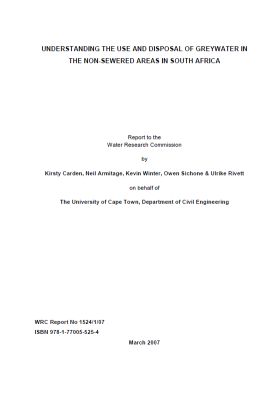Understanding the use and disposal of greywater in the non-sewered areas in South Africa - Report to the Water Research Commission WRC Report No 1524/1/07, South Africa
Carden, K. et al. (2007)

Published in: 2007
Author:
Carden, K. et al.
Uploaded by:
SuSanA secretariat
Partner profile:
common upload
6272 Views
71 Downloads
Location of library entry
Content - Summary
There is currently a strong drive from the South African government to ttain adequate water and sanitation coverage throughout the country and the basic level of service to meet this requirement being applied to the majority of authorities in urban and rural areas relates in most cases to on-site dry latrines (VIPs or similar) and 25 litres of potable water per capita per day (l/c.d) within 200m cartage distance. The targets for the provision of basic water services to all people in South Africa (SA) are set out in the “Strategic framework for water services” (DWAF, 2003), which outlines Government’s commitment to eliminating the backlogs and to
progressively improve these levels of service over time. In order to meet these targets (access to basic water supply by 2008, and to basic sanitation by 2010), the connection of low-income settlements to municipal water sources has subsequently occurred on a massive scale,
frequently without giving adequate attention to greywater management in those areas that are non-sewered. Recent estimates show that there are approximately 20 million people in SA without access to on-site waterborne sanitation (Statistics South Africa, 2005).
Bibliographic information
Carden, K. et al. (2007). Understanding the use and disposal of greywater in the non-sewered areas in South Africa - Report to the Water Research Commission WRC Report No 1524/1/07, South Africa.
Filter tags
Constructed wetlands English Groundwater protection (WG11) Practitioners Sub-Saharan Africa















